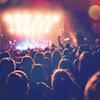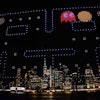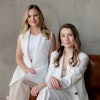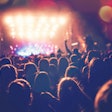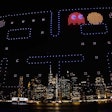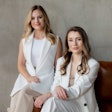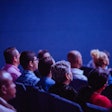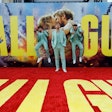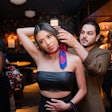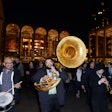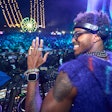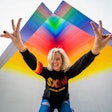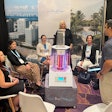Some may consider gray drab for an event, but when that event is the Whitney Museum of American Art's fall gala and the honoree is artist Chuck Close, the end result is anything but. At last night's benefit, one of the museum's galleries became a dark, elegant dining room, with hints of gray shades achieved mainly through the use of silvery metals and mirrors that complemented nine of the artist's large black-and-white tapestries, which lined three walls of the room.
Recently installed director of special events Gina Rogak oversaw the event, with Geoff Howell Studio tackling design and production. "Chuck Close requested that gray be the primary color for the event," Howell said. "[We] worked with that in terms of texture and color and added silver [with] brushed steel, frosted mirrors, and regular mirrors."
In fact, mirrors appeared prominently from the moment guests entered the museum's lobby, where a silvery, frosted-mirror pathway led from the gray-carpet arrivals area to the silver-topped reception desk that held guests' name cards. A large projection of candle flames shot against a pale gray background gave a soft light to the room, and horizontal bands of mirrors on side walls reflected the illumination.The dining room was where the gray dictate was in fullest effect, with walls painted a dark shade and hung with the large portraits of Close's artist-friends (Kiki Smith, Andres Serrano, Cindy Sherman, and Philip Glass among them). The works (along with two more in the cocktail area) were loaned as a set for the evening by the PaceWildenstein gallery. Custom-made dinner tables had tops with a wide band of frosted mirrors around the edges and a square of clear mirror in the center, which reflected a grouping of votive candles. Low arrangements of sunflowers gave a punch of yellow to the sleek, dark room. (The use of the flower echoed one of the tapestries, that of a lone sunflower.)
Four tall steel posts rose from the center of each table, topped with a platform of flickering votives that created a soft line of glowing light that played against the bottom edge of the large artworks. The tall steel table structures created a cool, open framework that helped show off the artwork when viewed from various points in the room.
Howell chose to install panels of waffle-textured gray foam (of the same size as each tapestry) between each portrait to help fill in the horizontal band of works along the walls. The foam panels also added some sound dampening (there was a piano performance by Bruce Levingston of Philip Glass's A Musical Portrait of Chuck Close during dinner), and the material's subtle patterns echoed the visual style of Close's own work.
Olivier Cheng's dinner consisted of a first course of a twice-baked aged goat cheese soufflé with hazelnuts and haricots verts, while the main course was a tagine of organic chicken with preserved lemons and picholine olives with pearl couscous. Diners were also served a banana tart with malt ice cream and butterscotch sauce for dessert.
Aside from all of the prominent grays of the event, the dinner and after-party raised a considerable amount of green for the museum, bringing in $2.4 million.
Recently installed director of special events Gina Rogak oversaw the event, with Geoff Howell Studio tackling design and production. "Chuck Close requested that gray be the primary color for the event," Howell said. "[We] worked with that in terms of texture and color and added silver [with] brushed steel, frosted mirrors, and regular mirrors."
In fact, mirrors appeared prominently from the moment guests entered the museum's lobby, where a silvery, frosted-mirror pathway led from the gray-carpet arrivals area to the silver-topped reception desk that held guests' name cards. A large projection of candle flames shot against a pale gray background gave a soft light to the room, and horizontal bands of mirrors on side walls reflected the illumination.The dining room was where the gray dictate was in fullest effect, with walls painted a dark shade and hung with the large portraits of Close's artist-friends (Kiki Smith, Andres Serrano, Cindy Sherman, and Philip Glass among them). The works (along with two more in the cocktail area) were loaned as a set for the evening by the PaceWildenstein gallery. Custom-made dinner tables had tops with a wide band of frosted mirrors around the edges and a square of clear mirror in the center, which reflected a grouping of votive candles. Low arrangements of sunflowers gave a punch of yellow to the sleek, dark room. (The use of the flower echoed one of the tapestries, that of a lone sunflower.)
Four tall steel posts rose from the center of each table, topped with a platform of flickering votives that created a soft line of glowing light that played against the bottom edge of the large artworks. The tall steel table structures created a cool, open framework that helped show off the artwork when viewed from various points in the room.
Howell chose to install panels of waffle-textured gray foam (of the same size as each tapestry) between each portrait to help fill in the horizontal band of works along the walls. The foam panels also added some sound dampening (there was a piano performance by Bruce Levingston of Philip Glass's A Musical Portrait of Chuck Close during dinner), and the material's subtle patterns echoed the visual style of Close's own work.
Olivier Cheng's dinner consisted of a first course of a twice-baked aged goat cheese soufflé with hazelnuts and haricots verts, while the main course was a tagine of organic chicken with preserved lemons and picholine olives with pearl couscous. Diners were also served a banana tart with malt ice cream and butterscotch sauce for dessert.
Aside from all of the prominent grays of the event, the dinner and after-party raised a considerable amount of green for the museum, bringing in $2.4 million.
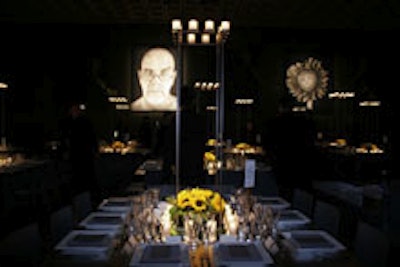
Tall steel platforms framed the portraits on the walls.
Photo: Alison Whittington for BizBash
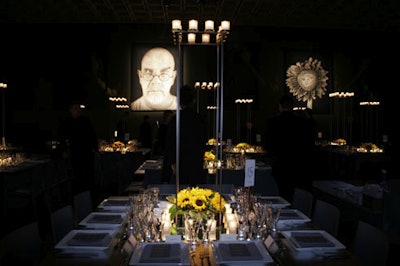
Tall steel platforms with votives towered over dinner tables and helped frame the large portraits on the walls.
Photo: Alison Whittington for BizBash
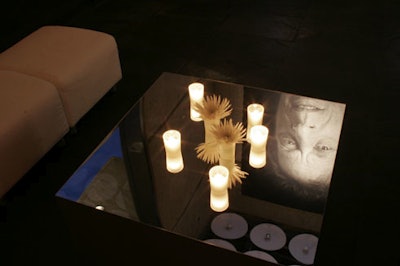
Mirror-topped tables in the cocktail space reflected Close's portrait of Philip Glass.
Photo: Alison Whittington for BizBash
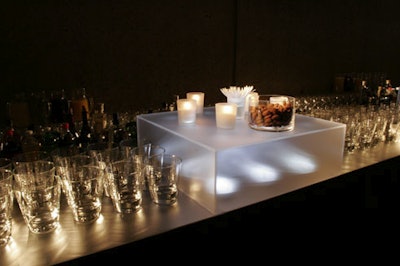
Silver tones topped the bars, echoing the event's shades of gray.
Photo: Alison Whittington for BizBash
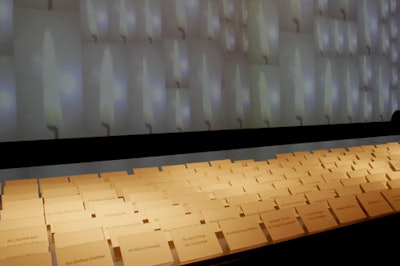
A large projection of candle flames made for a dramatic backdrop for guests' name cards and gave light to the museum's entry hall.
Photo: Alison Whittington for BizBash
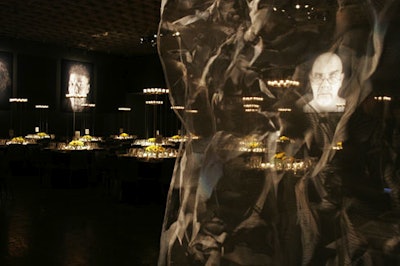
Crumpled curtains of metal mesh gave a reflective quality to the dining room.
Photo: Alison Whittington for BizBash
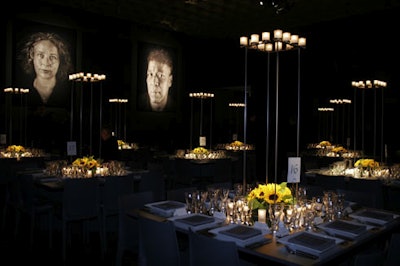
Portraits appeared to float throughout the dinner space.
Photo: Alison Whittington for BizBash
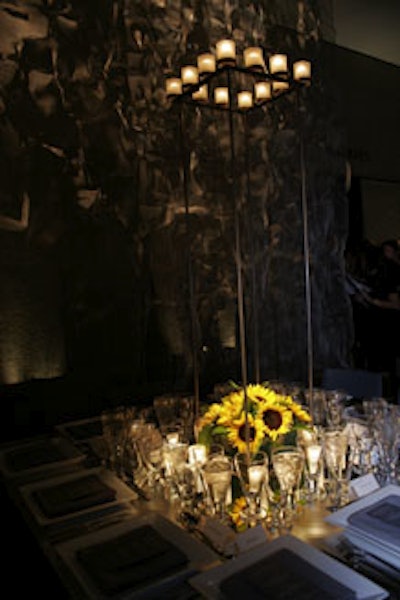
Clusters of sunflowers on each table echoed Close's large tapestry of a single stem of the flower.
Photo: Alison Whittington for BizBash
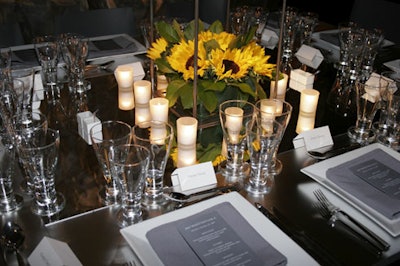
Custom-built tables featured a perimeter of frosted glass with a reflective square mirror in the middle to frame the votives and provide subtle light to the room.
Photo: Alison Whittington for BizBash
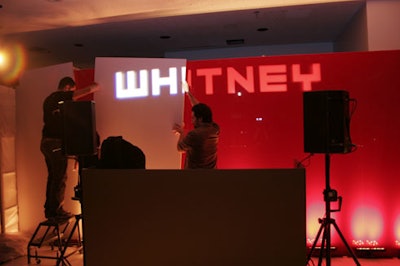
Workers revealed a burst of color, removing the white wall panels from the cocktail hour for the after-party.
Photo: Alison Whittington for BizBash
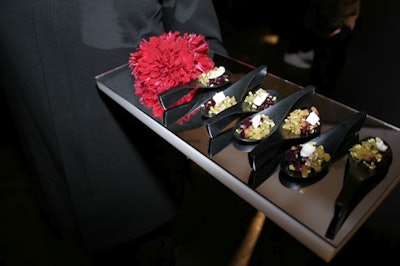
Olivier Cheng's hors d'oeuvres for the after-party included a medley of red and gold beets with dates and goat cheese.
Photo: Alison Whittington for BizBash

